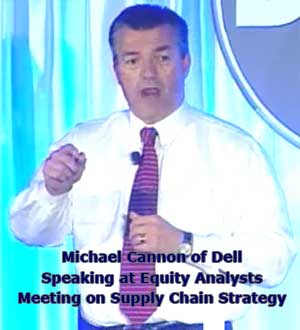It’s hard to argue that the direct model and Dell’s supply chain wasn’t the perfect answer for the company for a very long time. You got the company to 60 plus billion dollars. It’s hard to say that didn’t drive consistent profitability and enormous cash generation. But as you will hear throughout the course of the next day and a half, we have to evolve our model because our competitive environment is evolving and changing. And that has to do with the direct model. And you’ve all heard Michael talk about direct is not a religion, it is a business model.
 The direct model remains a primary focus of the company going forward. It is still hugely relevant, offers enormous value for customers and helps us win a lot of business our competitors can’t reach. So we are going to continue to perfect the direct model, but given how the market has changed overall, particularly in areas such as consumer, and the growth in emerging markets, we need more than just a direct model. You’ll hear over the next day and a half quite a bit about how Dell is entering the consumer market, retail in particular, developing a channel business. So that is an area where to satisfy our customers. We want to participate in growth segments, particularly the high growth segments where we have nice profit opportunity. We have to offer our full range of products and services in the way the customers want to buy them, not particularly in the way we want to supply them and provide them. So there will be quite a bit of change in that and I think some very exciting opportunities. The direct model remains a primary focus of the company going forward. It is still hugely relevant, offers enormous value for customers and helps us win a lot of business our competitors can’t reach. So we are going to continue to perfect the direct model, but given how the market has changed overall, particularly in areas such as consumer, and the growth in emerging markets, we need more than just a direct model. You’ll hear over the next day and a half quite a bit about how Dell is entering the consumer market, retail in particular, developing a channel business. So that is an area where to satisfy our customers. We want to participate in growth segments, particularly the high growth segments where we have nice profit opportunity. We have to offer our full range of products and services in the way the customers want to buy them, not particularly in the way we want to supply them and provide them. So there will be quite a bit of change in that and I think some very exciting opportunities.
Along with that, our supply chain needs to change dramatically. When you look back through the history of the company, we evolved a supply chain here in a manufacturing strategy that focused on building pretty amazing levels of complexity customization with very short cycle times, meaning we could respond the fastest to the customer order when they wanted a very uniquely configured product. Here again, we are going to continue to get better at that. There is a terrific business with delivering customers the customization levels, the personalization levels that they want, and doing it better than anyone else.
But there have evolved major segments of the market that don’t need that level of customization. They are quite happy with the fixed configuration or maybe very limited configurations, and they are quite OK with an extended cycle time or delivery time. So we can fulfill that demand with a different supply chain and lower cost geographies.
That is very much the kind of transformational work we are doing in global supply chain, the global operations organization in order to evolve our supply chain and make us more competitive in each major market. So how are we doing that? How are we making all those decisions about the supply chain?
I will talk about specific areas we are working on for cost reduction. It kind of starts out with the premise, from my perspective, that what we need to do is to provide the customers with great satisfaction on their needs, better than our competitors, in a way that delivers total lowest landed cost, anywhere in world.
Story Continued on Page 2
|